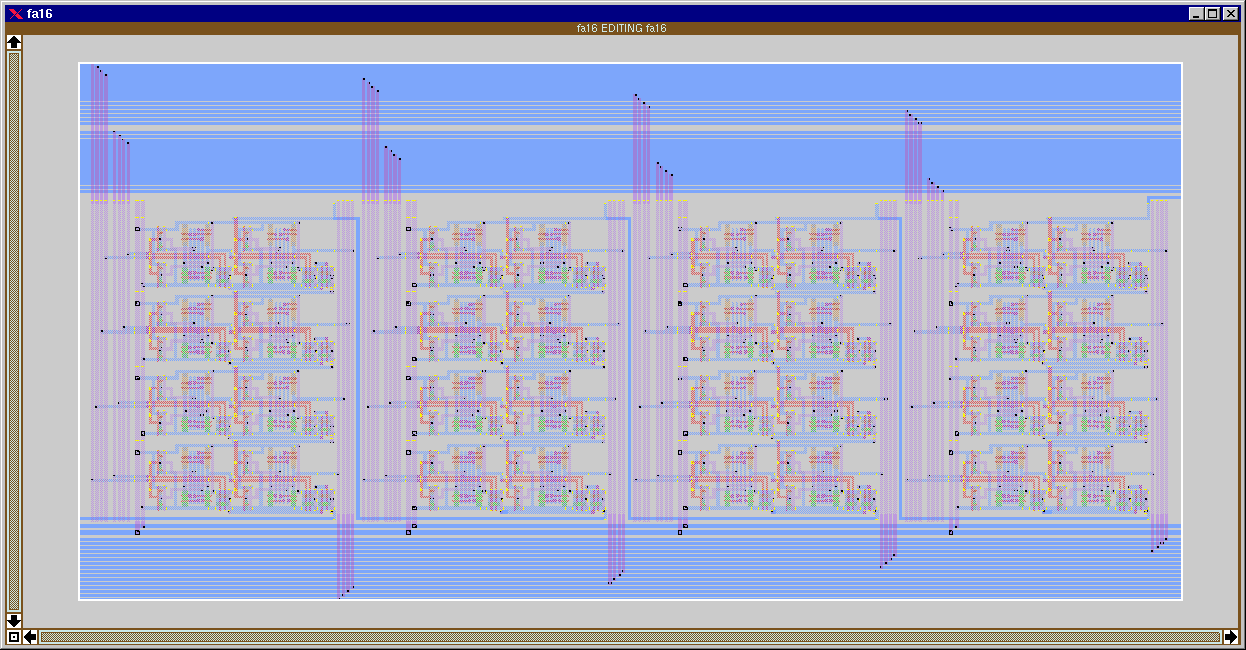Magic is an electronic design automation (EDA) layout tool for very-large-scale integration (VLSI) integrated circuit (IC) originally written by John Ousterhout and his graduate students at UC Berkeley. Work began on the project in February 1983. A primitive version was operational by April 1983, when Joan Pendleton, Shing Kong and other graduate student chip designers suffered through many fast revisions devised to meet their needs in designing the SOAR CPU chip, a follow-on to Berkeley RISC.
| Attributes | Values |
|---|
| rdf:type
| |
| rdfs:label
| - Magic (programari) (ca)
- Magic (software) (it)
- Magic (software) (en)
|
| rdfs:comment
| - Magic is an electronic design automation (EDA) layout tool for very-large-scale integration (VLSI) integrated circuit (IC) originally written by John Ousterhout and his graduate students at UC Berkeley. Work began on the project in February 1983. A primitive version was operational by April 1983, when Joan Pendleton, Shing Kong and other graduate student chip designers suffered through many fast revisions devised to meet their needs in designing the SOAR CPU chip, a follow-on to Berkeley RISC. (en)
- Magic è uno strumento per il layout VLSI dei circuiti integrati in origine scritto John Ousterhout ed i suoi studenti laureati all'Università di Berkeley nel 1980.Magic continua ad essere popolare perché software libero e gratuito distribuito sotto la "Berkeley open-source license", facile da usare e da implementare con funzionalità specializzate. La versione stabile attuale è la 7.5, ma le versioni 6.x sono ancora largamente usate. (it)
|
| foaf:name
| |
| name
| |
| foaf:depiction
| |
| dcterms:subject
| |
| Wikipage page ID
| |
| Wikipage revision ID
| |
| Link from a Wikipage to another Wikipage
| |
| Link from a Wikipage to an external page
| |
| sameAs
| |
| dbp:wikiPageUsesTemplate
| |
| thumbnail
| |
| author
| - John K. Ousterhout, Gordon T. Hamachi, Robert N. Mayo, Walter S. Scott, George S. Taylor (en)
|
| developer
| - Magic Development Team (en)
|
| genre
| |
| language
| |
| latest release date
| |
| latest release version
| |
| license
| |
| operating system
| |
| programming language
| |
| repo
| |
| has abstract
| - Magic és una eina de disseny d'automatització del disseny electrònic (EDA) per a circuits integrats (IC) d'integració a gran escala (VLSI) escrita originalment per i els seus estudiants de postgrau a la UC Berkeley. El desenvolupament va començar el febrer de 1983. Una versió primitiva estava operativa l'abril de 1983, quan Joan Pendleton, Shing Kong i altres dissenyadors de xips d'estudiants de postgrau van patir moltes revisions ràpides ideades per satisfer les seves necessitats en el disseny del xip de CPU SOAR, una continuació de . Tement que Ousterhout proposés un altre nom que comencés amb "C" per a coincidir amb els seus projectes anteriors Cm*, Caesar i Crystal, Gordon Hamachi va proposar el nom Magic perquè li agradava la idea de poder dir que la gent utilitzava la màgia per dissenyar xips. La resta de l'equip de desenvolupament va acceptar amb entusiasme aquesta proposta després que va idear el retroacrònim M anhattan A rtwork G enerator for I ntegrated C ircuits. Els desenvolupadors de programari Magic es deien a si mateixos mags, mentre que els dissenyadors de xips eren usuaris de Magic. Com a programari lliure i de codi obert, subjecte als requisits de la llicència BSD, Magic continua sent popular perquè és fàcil d'utilitzar i fàcil d'ampliar per a tasques especialitzades. (ca)
- Magic is an electronic design automation (EDA) layout tool for very-large-scale integration (VLSI) integrated circuit (IC) originally written by John Ousterhout and his graduate students at UC Berkeley. Work began on the project in February 1983. A primitive version was operational by April 1983, when Joan Pendleton, Shing Kong and other graduate student chip designers suffered through many fast revisions devised to meet their needs in designing the SOAR CPU chip, a follow-on to Berkeley RISC. Fearing that Ousterhout was going to propose another name that started with "C" to match his previous projects Cm*, Caesar, and Crystal, Gordon Hamachi proposed the name Magic because he liked the idea of being able to say that people used magic to design chips. The rest of the development team enthusiastically agreed to this proposal after he devised the backronym Manhattan Artwork Generator for Integrated Circuits. The Magic software developers called themselves magicians, while the chip designers were Magic users. As free and open-source software, subject to the requirements of the BSD license, Magic continues to be popular because it is easy to use and easy to expand for specialized tasks. (en)
- Magic è uno strumento per il layout VLSI dei circuiti integrati in origine scritto John Ousterhout ed i suoi studenti laureati all'Università di Berkeley nel 1980.Magic continua ad essere popolare perché software libero e gratuito distribuito sotto la "Berkeley open-source license", facile da usare e da implementare con funzionalità specializzate. La versione stabile attuale è la 7.5, ma le versioni 6.x sono ancora largamente usate. Le funzionalitò di Magic è la progettazione Sistema real-time e verifica in tempo reale, cosa che alcuni costosi pacchetti software commerciali di VLSI design non possiedono. Magic implementa questa funzione contando la distanza utilizzando la distanza di Manhattan (Manhattan distance) piuttosto che la distanza euclidea, che è molto più veloce da calcolare. Magic attualmente gira sotto Linux, anche se le versioni esistono per DOS, OS/2, e altri sistemi operativi. Magic è frequentemente usato in abbinamento con e altri programmi di simulazione. (it)
|

![http://dbpedia.demo.openlinksw.com/describe/?url=http%3A%2F%2Fdbpedia.org%2Fresource%2FMagic_%28software%29]()



![[RDF Data]](/fct/images/sw-rdf-blue.png)



![[RDF Data]](/fct/images/sw-rdf-blue.png)




![[cxml]](/fct/images/cxml_doc.png)
![[csv]](/fct/images/csv_doc.png)
![[text]](/fct/images/ntriples_doc.png)
![[turtle]](/fct/images/n3turtle_doc.png)
![[ld+json]](/fct/images/jsonld_doc.png)
![[rdf+json]](/fct/images/json_doc.png)
![[rdf+xml]](/fct/images/xml_doc.png)
![[atom+xml]](/fct/images/atom_doc.png)
![[html]](/fct/images/html_doc.png)